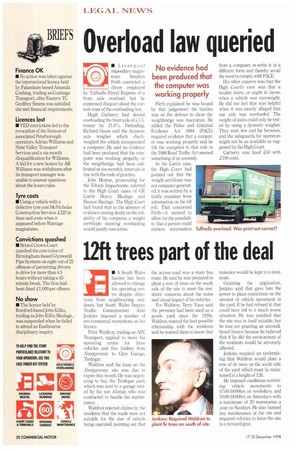'llE" Overload law queried
Page 22

If you've noticed an error in this article please click here to report it so we can fix it.
• Liverpool sl ipenclary magis trate Stephen Firth convicted a driver employed by Tuffnells Parcel Express of a front axle overload, but he expressed disquiet about the current state of the overloading law Hugh Carberry had denied overloading the front axle of a 7.5tonner by 21.6%. Defending, Richard Green said the dynamic axle weigher which checkweighed the vehicle incorporated a computer. He said no evidence had been produced that the computer was working properly, or the weighbridge had been calibrated at six-monthly intervals in line with the code of practice.
John Heaton, prosecuting for the Vehicle Inspectorate, referred to the High Court cases of GE Curtis Heavy Haulage and Heanor Haulage. The High Court had found that in the absence of evidence casting doubt on the reliability of the computer, a weight certificate showing overloading would justify conviction.
Firth explained he was bound by that judgement: the burden was on the defence to show the weighbridge was inaccurate. He added the Police and Criminal Evidence Act 1984 (PACE) required evidence that a computer was working properly and he felt the exception to that rule in the 1988 Road Traffic Act seemed something of an anomaly.
In the Curtis case, the High Court had pointed out that the weight certificate was not computer-generated; it was written by a traffic examiner from information on the till roll. That concerned Firth—it seemed to allow for the possibik ty that a person could retrieve information from a computer, re-write it in a different form and thereby avoid the need to comply with PACE.
His other concern was that the High Court's view was that a haulier knew, or ought to know, when a vehicle was overweight. He did not feel that was helpful when it was merely alleged that one axle was overloaded. The weight of axles could only he tested by using a dynamic weigher. They were few and far between, and the safeguards for operators might not be as available as suggested by the High Court.
Carberry was fined I-50 with 1:100 costs.












































































































































